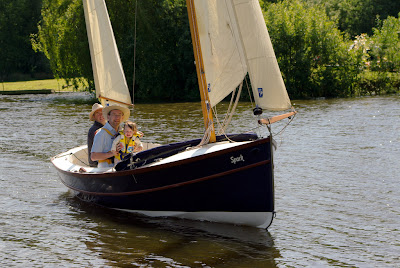That's always the reason for so little progress. This weekend I managed to steal about 2 hours to work on the boat.
An hour spent sharpening up some chisels. A flat waterstone grinder is the thing for flattening the back of your chisels. But the jig is really for planer blades. It's not great for chisels. A 120 grit Japanese Water stone will reshape your chisel in short order, and a set of Ice Bear Waterstones will get it silly sharp.
I cheat and use the Veritas Mk II sharpening Jig. Maybe with more practice...
All this sharpening was to allow me to spend the second hour changing the angle of some notches in the frames that join the transom. Of course if I had cut them right in the first place....
At any rate, it's kind of scary to see how easily a truly sharp chisel will cut through Solid Oak, even end Grain. Fingers Behind the blade and all that.
Monday, June 30, 2008
Wednesday, June 11, 2008
Beale Park 2008
In spite of promises of dark overcast days and heavy showers, the main concern this weekend in Reading was sunburn.
We made our second annual visit to the Beale Park boat show.

Amongst the highlights for me was bringing Sarah - my 18 month old daughter out sailing on a Bay Raider. Lovely boat. I want one. Actually, How about a Sea Raider.

Sarah appeared to love it, though she was trying to lean out overboard, and was saying "swim swim swim". We did manage to avoid testing her life jacket on this occasion.
Some time later I managed to find a kind gentleman from the wooden boat builders association who taught me to eye splice.
It's one of those things that's not really that difficult when you see it done, but try learning it from a book. If you follow the link to the eyesplice above, it all hinges on picture 9.
Some of the work there on display was amazing, including a newly build Salcombe Yawl. Nice, but a little spendy at £25,596 (a little under $50,000). I guess you get what you pay for.
There were rowing skiffs, sail boats, electric launches and steam boats..

To top it all off - we stayed at the Beetle and Wedge a nice restaurant along the thames which has a few rooms for B&B. The food was fantastic. The staff made us feel like old friends, and Sarah got to feed the ducks at the river bank. The ducks were simply brazen. While Sarah was tearing bits of bread a slice off to through to the ducks, one came around behind her and snatched the slice clean from her hands.
Four days of very civilised living in the english countryside. Excellent.
We made our second annual visit to the Beale Park boat show.

Amongst the highlights for me was bringing Sarah - my 18 month old daughter out sailing on a Bay Raider. Lovely boat. I want one. Actually, How about a Sea Raider.

Sarah appeared to love it, though she was trying to lean out overboard, and was saying "swim swim swim". We did manage to avoid testing her life jacket on this occasion.
Some time later I managed to find a kind gentleman from the wooden boat builders association who taught me to eye splice.
It's one of those things that's not really that difficult when you see it done, but try learning it from a book. If you follow the link to the eyesplice above, it all hinges on picture 9.
Some of the work there on display was amazing, including a newly build Salcombe Yawl. Nice, but a little spendy at £25,596 (a little under $50,000). I guess you get what you pay for.
There were rowing skiffs, sail boats, electric launches and steam boats..

To top it all off - we stayed at the Beetle and Wedge a nice restaurant along the thames which has a few rooms for B&B. The food was fantastic. The staff made us feel like old friends, and Sarah got to feed the ducks at the river bank. The ducks were simply brazen. While Sarah was tearing bits of bread a slice off to through to the ducks, one came around behind her and snatched the slice clean from her hands.
Four days of very civilised living in the english countryside. Excellent.
Wednesday, June 04, 2008
Thanks Bro'
I convinced my brother to come join me for a spot of boat building. I had 4 long (14'-16') oak planks to plane down to 22mm and cut into long strips for battens.
Hard to man handle all alone.
My PT85 was quite inadequate for the task. It would plane oak just fine for a while, but then just overheat and give up the ghost. Unless I wanted to run a board through, then shoot the breeze for 20 minutes and repeat (not a bad idea, but my time is limited) then I needed bigger iron.
I rented a Makita 2012NB from SamHire for the weekend. Like many hire shops they treat weekends as non business days, so I got it for 3 days for the price of 1.5 - In the end, due to various commitments, I only used it for about 3/4 of a day - but that was enough.
We spent quite a while running 15' planks through the planer, and got things down to a fine art. In retrospect, I should have just paid The Lisnavagh Timber Project a few bob to run it through their big industrial planer and it would only have taken an hour or so. You live and learn.
Cutting the battens is made easier by a very simple trick. Clamp the planks to bits of scrap on top of your workbenches. Then set the blade so that it cuts the oak, and cuts into, but not through the scrap. Now you don't have to get inventive about how you clamp the wood so as not to cut your workbenchs in half. So simple.
In fact for the first few battens, the oak was heavy enough not to even need clamps - do clamp the scrap bits - unless you want to see how far your saw can fling them.
Next up will be steaming the chine logs and the sheer clamps.
Hard to man handle all alone.
My PT85 was quite inadequate for the task. It would plane oak just fine for a while, but then just overheat and give up the ghost. Unless I wanted to run a board through, then shoot the breeze for 20 minutes and repeat (not a bad idea, but my time is limited) then I needed bigger iron.
I rented a Makita 2012NB from SamHire for the weekend. Like many hire shops they treat weekends as non business days, so I got it for 3 days for the price of 1.5 - In the end, due to various commitments, I only used it for about 3/4 of a day - but that was enough.
We spent quite a while running 15' planks through the planer, and got things down to a fine art. In retrospect, I should have just paid The Lisnavagh Timber Project a few bob to run it through their big industrial planer and it would only have taken an hour or so. You live and learn.
Cutting the battens is made easier by a very simple trick. Clamp the planks to bits of scrap on top of your workbenches. Then set the blade so that it cuts the oak, and cuts into, but not through the scrap. Now you don't have to get inventive about how you clamp the wood so as not to cut your workbenchs in half. So simple.
In fact for the first few battens, the oak was heavy enough not to even need clamps - do clamp the scrap bits - unless you want to see how far your saw can fling them.
Next up will be steaming the chine logs and the sheer clamps.
Subscribe to:
Posts (Atom)

